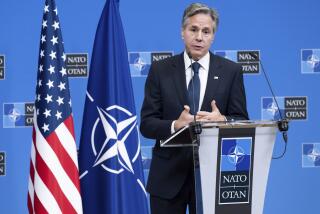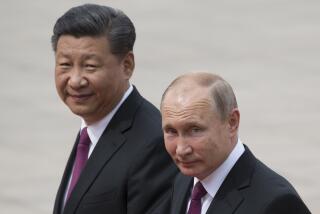China’s military must open up, U.S. says
- Share via
BEIJING — After Marine Gen. Peter Pace, the outgoing chairman of the Joint Chiefs of Staff, visited China in March, he came home glowing about the access he had been given. He had sat in the Chinese military’s top fighter plane and ridden in its most sophisticated tank.
“They took me to places no other U.S. officer had been,” Pace said. “They took me to their private offices. They took me to their command centers and showed me their maps and their plans.”
But others in the Pentagon were less impressed.
In the months that followed, senior Defense officials insisted that U.S. officers were routinely being denied access to Chinese sites during trips here, even as the Americans allowed visiting Chinese officers into some of the United States’ most sophisticated and advanced facilities.
“What we expect the Chinese to do is give us the same level of access that we give them here in the United States,” Richard P. Lawless, who recently stepped down as the Pentagon’s top Asia hand, said last month in a valedictory news conference.
“We make a great effort to give them access -- reasonable access -- and we make a great effort to let them understand how our military really works, and if that cannot be reciprocated, then we have a very serious disconnect,” Lawless added.
That reciprocity will be put to the test starting today, when Pace’s designated successor, Navy Adm. Michael G. Mullen, arrives here. His trip will include not only Beijing, but also naval facilities all along China’s northeastern and eastern coasts, including its prestigious naval academy in Dalian.
Pentagon officials acknowledge that the bickering may seem petty. But they also insist that such visits go beyond symbolism.
Beijing’s failure to allow more wide-ranging access during high-level trips, they argue, is symptomatic of China’s failure to explain the direction of its military buildup.
“I don’t want to make everything about the visits, because it’s not all about the visits and only about the visits,” Lawless said. “But the visits are an important meter stick or indicator of what this relationship is and what it is not.”
For the Pentagon, Mullen’s trip has become a high-profile case in point.
His visit to China was already postponed once after U.S. officials decided Mullen, who is currently the U.S. Navy’s top officer, was not getting the kind of access granted the head of the People’s Liberation Army’s navy, Vice Adm. Wu Shengli, during his visit to the United States in April.
Wu’s trip included stops at Pearl Harbor, the U.S. Naval Academy in Annapolis, Md., and the Navy’s main East Coast base in Norfolk, Va., where he toured the aircraft carrier Harry S. Truman.
The Pentagon regarded the tour of the carrier as a particularly magnanimous gesture, given U.S. concerns that China may be developing its own carrier program.
Through a spokesman, Mullen said he looked forward to reconnecting with Wu and other senior naval leaders and expressed satisfaction with the itinerary.
“He appreciates the effort these leaders have put into making sure his visit is productive,” Navy Capt. John Kirby said.
The U.S. has been complaining with varying intensity for years about the access during such visits. And in March, Vice President Dick Cheney accused Beijing of concealing its military ambitions.
China bristled at Cheney’s criticism.
“If someone wanted you to take your clothes off and lifted your underwear, saying, ‘Let me see what’s inside,’ how would you feel? Would you not call the police?” Foreign Ministry spokesman Qin Gang said.
The frequency of top-level visits to China by the U.S. military has picked up significantly over the course of the Bush administration, and this year is on course to be the busiest yet. Mullen’s visit will be the fourth by a four-star officer in the last five months.
Peter Rodman, an analyst at the Brookings Institution who oversaw international security affairs at the Pentagon until March, said the visits are part of a concerted, five-year effort by the White House to increase military ties between the two countries.
The push came after one of the lowest points in recent Sino-American relations, when a Navy spy plane was forced to land on a Chinese airstrip in April 2001 after colliding with a Chinese fighter jet.
The Chinese jet crashed, killing the pilot. China detained the Navy EP-3 crew of 24 for 11 days, and the Pentagon subsequently cut off all military contacts for months.
The incident highlighted the lack of familiarity between the two countries’ military brass.
Current and former U.S. officials acknowledge that since then, progress has been made in China’s openness to explaining its security goals and in its providing more access to visiting American officers.
In particular, Pentagon officials point to China’s decision in December to release a new defense white paper, which they said provided some of the clearest explanations to date as to Beijing’s strategic thinking.
But these same officials argue that such advances have been incremental at best.
“We are always seeking greater transparency and reciprocity in these exchanges,” Rodman said. “Their people routinely have access to facilities and people in the U.S. that we do not receive there.”
The Pentagon believes that there are strategic issues involved in China’s reluctance to be more open.
In its annual report to Congress on Chinese military power, issued in May, Defense Department analysts suggested that Beijing uses deception and obfuscation to keep adversaries off balance.
They noted that late paramount leader Deng Xiaoping had once said that to “hide our capabilities and bide our time” was central to China’s security policy.
Retired Adm. Dennis Blair, former head of U.S. forces in the Pacific, said that during his visits to China nearly a decade ago, he would frequently face similar arguments.
“I would get constant lectures on the Chinese military philosopher, Sun Tzu, who believes that through deception and veiling your intentions you can win a thousand battles without firing a shot,” Blair said at a recent meeting with reporters.
But he said some of the reticence was also probably rooted in the still-modest levels of Chinese military capabilities, which Chinese commanders are loath to reveal.
Ni Lexiong, a military expert and professor at the Shanghai Institute of Political Science and Law, agreed. But he said the U.S. military used visits by Chinese officers to show off its superiority and intimidate its guests.
“A strong and powerful state is not afraid of being seen by others,” he said, noting that the U.S. sends a clear message through such visits: “You know how strong I am. You are weaker than me; I’m not afraid of you.”
Defense Secretary Robert M. Gates said during a June trip to Asia that he believed China was becoming more forthcoming about its strategic aims, but that bilateral military relations still lacked the kind of regularity that would make both sides more confident in the event of a crisis.
Gates, trained as a Soviet expert at the CIA, pointed as a model to the frequent and labor-intensive arms talks that characterized the Cold War.
“The years-long negotiations on strategic arms limitations may or may not have made much of a contribution in terms of limiting arms,” Gates said in response to a question by a Chinese officer. “But they played an extraordinarily valuable role in creating better understanding on both the Soviet and American sides about what the strategic intentions of each side were.”
--
Gu Bo in The Times’ Beijing Bureau contributed to this report.
More to Read
Sign up for Essential California
The most important California stories and recommendations in your inbox every morning.
You may occasionally receive promotional content from the Los Angeles Times.










